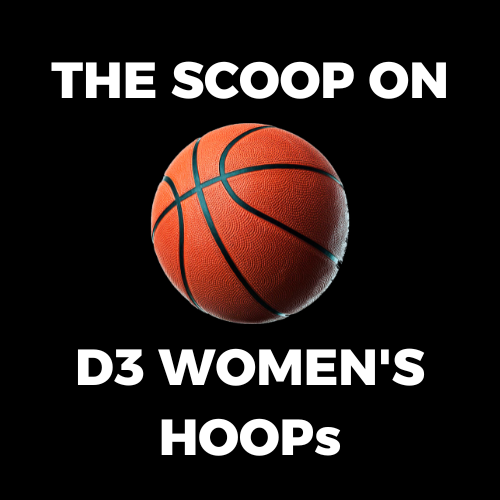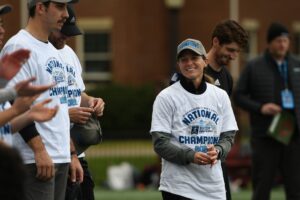Jan. 12, 2024
By Riley Zayas
Welcome back to another edition of D3 WBB Daily! We saw some fantastic basketball last night in the ASC and Centennial Conference, and tonight brings us NESCAC, Landmark, and UAA contests, several of which are going to be incredibly key in conference title races. As always, I’ll start with a few storylines/thoughts on last night’s action and the day ahead, before touching on some other notable performances/stats/results, and looking ahead to today’s games to watch.
Hope everyone has had a great start to their Friday!
Tipping Off
Mary Hardin-Baylor’s incredible comeback at #14 Hardin-Simmons
In what was the best game I’ve seen so far this week, and certainly one of the better games I’ve seen this season, the Top 25 battle between #20 Mary Hardin-Baylor and #14 Hardin-Simmons more than lived up to the hype. An overtime battle that saw UMHB go on the road to Abilene and emerge with a dramatic 93-89 victory also featured one of the best comebacks of the season, as UMHB made a statement.
HSU, a strong outside shooting team, went 6-for-11 from beyond the arc in the third quarter, taking a 15-point lead with 1:14 left. By the end of the third, UMHB trailed 63-50, and HSU had the momentum. With the way the Cowgirls were shooting against The Cru’s zone defense, it did not seem like UMHB would have enough to get back in it.
Turns out they did. UMHB outscored HSU 26-13 in the 4th, even taking the lead with 1:57 left, before a late corner 3 from HSU’s Aiken Semones sent the game in OT. The Cru led for the majority of OT, and held on for the road victory, which was pretty impactful in both the ASC race and Region 10. With the win, UMHB now holds a head-to-head result against HSU, as well as a two-game lead ahead of the Cowgirls in the league standings, and also now has one more RRO win, creating further separation between the two resumes.
Scott Peterson summed it up best last night as the game drew to a close: “Mary Hardin-Baylor is about to take a commanding hold of the top projected spot in Region 10. As of right now, any Texas NCAA Tournament teams will need to win at UMHB.”
I do want to note that as far as a Top 25 impact, here’s how I’m seeing it. UMHB proved its 13-1 record was no fluke by winning on the road in what is considered by many to be the toughest road environment in the ASC. Now 14-1 (with a 14-game winning streak), UMHB has a strong result it can point to and will be ranked ahead of HSU in my ballot this next week (of course, UMHB still has to play a tough McMurry team on Saturday). Now, HSU lost, but it was also in OT. The Cowgirls may drop slightly, but not by a great amount in my ballot. The 3-point shooting was absolutely fantastic. Semones was incredible off the bench, shooting 5-of-8 from 3-point range, and she wasn’t the only one. The Cowgirls had a pair of strong quarters in the second and third, and I think the comeback said more about UMHB than it did HSU. Ultimately, we’ve got two really solid Top 25-caliber programs in the ASC right now, which is great to see. They meet again in Belton on Feb. 17 on the final day of the regular season.
Intriguing matchup tonight between Middlebury and Bowdoin
We have Scranton/Catholic, Emory/WashU, and Amherst/Tufts, that will all certainly be interesting and especially impactful from a national perspective. But keep an eye on Bowdoin’s matchup at Middlebury. Right now, there is only one 2-0 team in the NESCAC; that’s Middlebury, who won at both Hamilton and Amherst last weekend. Bowdoin is 1-0, and likely to have been 2-0 if not for the winter storm that blew across the northeast last week. The Polar Bears’ victory came by 15 over a solid Trinity (CT) squad, and Bowdoin continues to move up in the Top 25 Polls. Ranked 15th, ahead of Amherst, Bowdoin is a tough out for anybody, and very much on a roll, with a 13-1 record. Middlebury, on the other hand, has the league’s No. 1 defense, despite struggling to defend the 3 (opponents shooting a league-best 31.2% from 3). Unfortunately for Middlebury, Bowdoin is also the No. 1 3-point shooting team in the NESCAC right now. I think this one comes down to which team is more effective from the perimeter. Interested in this outcome, especially because of the nature of the NESCAC’s single round-robin scheduling format, with everyone only playing each other once in the regular season.
Statement opportunity for Catholic tonight
On Hoopsville yesterday, I brought up Catholic as my “debatable” team, noting that while the #13 ranking is appropriate considering the perfect 13-0 record and the fact that the Cardinals are still undefeated when most others aren’t, Catholic also has been tested a great deal. Their SOS ranks #200 by Massey Ratings and at this point, Catholic has just two Top 100 results (@ Elizabethtown, and vs Marymount). But that changes tonight, as we’ll get a much clearer answer on where Catholic stands, both within the Landmark Conference and the Top 25, as the Cardinals face Scranton at home. Scranton remains ranked ahead of Catholic, but does have one conference loss already, having fallen at Elizabethtown, where Catholic has already won (as Gordon Mann correctly pointed out yesterday on Hoopsville). This is a chance for a breakthrough game for Catholic, and would be pretty impactful in the Landmark title race. Not to mention the regional rankings as well. That said, Scranton is a very talented squad who has found ways to win at Catholic time and time again. The Lady Royals need to avoid a second loss as best as possible, and surviving a road test at Catholic would be pretty impactful from that standpoint.
Fast Breaks
» Congratulations to Hardin-Simmons’ Paris Kiser, who surpassed the career 1,000-point mark against UMHB last night. Kiser had 22 points, and is No. 2 in the ASC in points per game.
» #11 Johns Hopkins pulled away from Swarthmore on the road, 78-65, in what was a pretty entertaining contest. JHU led 35-30 at halftime, but made a key third-quarter run and gained separation.
» Muhlenberg’s record may not show it, but the Mules are a tough opponent, especially at home. Gettysburg, however, weathered the road test yesterday, and came away with a 72-58 victory. The Bullets won the rebounding battle by 10 and shot 45.5%.
» Yesterday’s smallest margin of victory saw Principia defeat Westminster (Mo.) in SLIAC play, 55-54. Principia took the lead on a layup with 48 seconds left, and came up with two key defensive stops, earning the win.
» We’ve got Amherst/Tufts tonight. According to Amherst’s opponent history (on athletics.amherst.edu), the Mammoths have won the last four meetings played at Tufts, with Tufts’ last home regular season win over Amherst coming in 2015.
» Millsaps at Rhodes tonight features the only two teams in the SAA who are undefeated in league play. In a one-bid league like the SAA, games like this one are especially impactful. Millsaps is the favorite, but Rhodes will be on its home court, and I’ll be interested in how this one unfolds.
Looking Ahead
#6 Emory at #25 WashU, 6:30 pm ET
#9 Scranton at #13 Catholic, 7:00 pm ET
#15 Bowdoin at Middlebury, 7:00 pm ET
#16 Amherst at Tufts, 7:00 pm ET
Millsaps at Rhodes, 7:00 pm ET
Willamette at Puget Sound, 7:00 pm ET










 However, I found myself struggling more to read the “tea leaves.” Having an understanding how I felt a particular team finished last season is useful information. And it helps me appreciate how much a team has lost or gained in the offseason. By coming in without that info, my analysis of a team’s strengths and weaknesses was broader. I felt more unsure about where I felt a team was or wasn’t when it came to my ballot.
However, I found myself struggling more to read the “tea leaves.” Having an understanding how I felt a particular team finished last season is useful information. And it helps me appreciate how much a team has lost or gained in the offseason. By coming in without that info, my analysis of a team’s strengths and weaknesses was broader. I felt more unsure about where I felt a team was or wasn’t when it came to my ballot.

